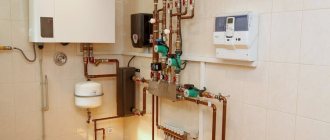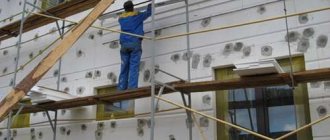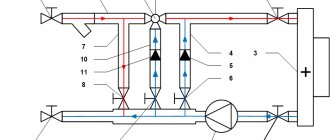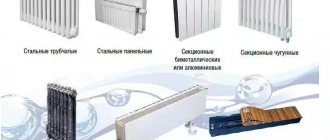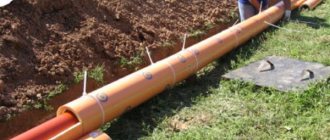The best option for quickly heating cold rooms in the off-season is to use fan heaters. The simple design and low cost of these devices made them mega-popular among citizens. But choosing the right one is not so easy - it’s easy to get confused in the huge assortment from different manufacturers.
We will help you figure out how to choose a fan heater for heating, for which we will study the options for their design and features of use in various conditions.
We will also present the main criteria that influence the choice of device and give practical recommendations to future buyers.
How does a fan heater work?
Any fan heater consists of three main parts: the housing, the heating element and the fan.
The operating principle is extremely simple. The fan captures cold air and directs it to the heating element, where it warms up. Using the same fan, the air is blown back into the space already warm.
Because of this mechanism, the devices were nicknamed “wind blowers” or “heaters with a fan.”
All of the above elements may have a different structure, and the reliability and functionality of the equipment depend on this. So we will talk about every detail in detail.
The main disadvantage of all heating devices is the noise they produce, which is explained by the rotation of the blades. In terms of volume, they are classified as follows (from quietest to loudest):
- infrared;
- oil and convector;
- fan heaters and heat guns.
So be prepared for a monotonous hum. Moreover, the more powerful the unit, the louder it works.
But this minus does not detract from the main advantage - quick heating of the room. This happens precisely because of the presence of a fan. It enhances the circulation of air masses, and a comfortable microclimate is achieved in a short time.
Owner reviews of ceramic fan heaters: advantages and disadvantages
Users especially note the manufacturability and durability of these devices. A ceramic fan heater, according to most owners, is universal. Power and safety allow it to be used even in children's rooms.
After analyzing the published comments, we were able to identify the main pros and cons of the products.
| Advantages | Flaws |
| Manufacturability | Price |
| Efficiency | Long-term access to operating modes |
| Economical | Increased weight |
| Durability | Overheating of objects (close to the device) |
| Safety | |
| Reliability | |
| Environmental friendliness | |
| Versatility | |
| Ease of use | |
| Maintainability |
The opinions of real people can be subjective and fundamentally different from each other. At the same time, statistics show a confident annual increase in sales of this particular type of device. According to official data, the ratio is almost 70 to 30 (ceramics/spiral). The overwhelming majority of buyers insist that spiral heaters remain relevant solely due to their low price.
Device classification
One of the options is division by scope:
- industrial – high-performance installations designed for round-the-clock operation and with improved characteristics;
- household - inexpensive and compact specimens used in houses and apartments.
The main feature by which all devices are classified is the installation method. The equipment is divided into two groups: stationary and mobile.
Stationary
This technique requires thorough fastening. It cannot be moved immediately and the installation site will often have to be prepared.
But this category of electric heaters, as a rule, is distinguished by increased power and expanded functionality. Therefore, the object can be used even as the only heating device.
This system is also safer, since there is no chance of it tipping over or getting a random object inside.
As a rule, these samples are equipped with remote control via a remote control. Otherwise, you will have to climb onto a chair or stepladder and manually adjust the settings.
There are two options for permanent installation.
- Wall
In appearance they resemble an air conditioner. Some models are equipped with rotating curtains, and then it is possible to direct the stream where you need it. But most do not send the flow to the side, but straight down.
They are often placed to create a thermal curtain over doors. They heat and prevent the cold from the street from penetrating inside. This is especially true in organizations with high traffic: shops, hospitals, schools, etc.
- Ceiling
As the name implies, such units are attached to the ceiling, which means that effort will be required during installation. But heaters direct warm masses in all directions and warm even a huge room.
Mobile
Their small size and weight make them easy to move. The device also allows you to set the direction of the heat flow and quickly warm up, for example, a bed. This is the best choice for an apartment in case of heating for a short period.
Among all the diversity, two groups of devices stand out.
- Floor-standing - have a variety of designs: cubic, column-shaped, horizontal cylinder.
- Tabletop - differ in the smallest size and weight. They come in horizontal and vertical versions.
There are also combined products that can be placed in different positions. One of the types of mobile units are heat guns.
Temperature control methods, modes
Any fan heater always has a thermostat. Which one is better to choose and buy for your home? The simplest devices have mechanical switches. The temperature is adjusted by simply turning the knob. For older people who do not like modern technology, this is convenient. Some products operate in automatic mode: when the room cools down, the device turns on again.
Samples with remote control, remote control and display are more convenient. Using the buttons you can set the desired temperature. There are models with a working time timer. How to use the fan heater is described in the attached instructions.
Related articles: Why install video surveillance in a private home
Power
The main question to be resolved is: what power wind turbine is needed. After all, a device with lower productivity will not be able to effectively heat a home. And if you buy a device with high performance, the electricity consumption will increase.
Old aluminum wiring often cannot withstand the load and ignites. The bulk of the sockets are designed for a maximum current of 16A: this corresponds to an equipment power of 3.5 kW.
The classic calculation is when per 10 sq. m of room requires 1 kW. It is also advisable to add a margin of 10-15%.
Devices for a small room or an addition to the heating system of 1-1.5 kW will be quite enough.
To calculate the power for heating only with an electric fan heater, you need to take into account many parameters - the number of windows, orientation to the cardinal directions, quality of double-glazed windows, climate, etc. It is better to entrust the calculation to a specialist, but you can do it yourself using a special calculator (available on the Internet).
A simplified formula looks like this:
W = S x W beat. /10, where
W – required power;
S – heated area;
W beat – specific power required for heating 10 sq. m in your climate zone.
| Climatic zone of Russia | W beat., kW |
| Southern regions | 0,7-0,9 |
| Middle lane | 1-1,2 |
| Northern regions | 1,5-2 |
Guarantee
- The standard warranty period for the operation of a fan heater is 12 months from the day it was sold. From the date of production it is no more than 24 months.
- In some cases, an extended warranty is provided for products, which is 60 months from the date of manufacture. You can check the availability of an extended warranty at a service center, in a store or on the manufacturer’s website.
- Upon purchase, a warranty book with tear-off coupons is provided. If there is no mark of the trading company in the instruction manual, the warranty period is calculated from the date of production.
The owner reserves the right to free repairs during the warranty period. The workshop removes the tear-off coupon after each repair. Accounting is kept in the warranty book.
In case of violation of the operating rules, the heating unit is automatically removed from the warranty. From now on, repair work is carried out at the buyer's expense.
The exchange of goods under warranty occurs in accordance with the rules that apply at each retail outlet.
The buyer is deprived of warranty rights if:
- the sales certificate and warranty card are filled out incorrectly;
- there is no passport or warranty card;
- the product was used for other purposes or in violation of the operating rules;
- the product was damaged mechanically, chips, cracks or deformation of the case were found on it;
- traces of self-repair or any other implementation were found;
- The design of the fan heater has been changed;
- foreign substances (sand, clay, dust and soot) were found inside the device;
- the serial number is completely or partially erased;
- the fan heater was exposed to strong humidity, which caused rust, or aggressive chemicals;
- the problem is related to improper connection to the electrical network and to all external sources of electricity;
- The fault has occurred in an electrical source that is not grounded.
The warranty does not apply to cases related to natural disasters and accidents, and to products that come with the equipment, since they work for a short period of time.
The warranty terms do not include cleaning the fan heater and repair services visiting your home.
A heating element
The central link of the entire mechanism is the heating element. It is he who largely determines the capabilities of a particular model. Even before purchasing, you will have to figure out which is better - a spiral or ceramic heater to purchase. Or maybe a water heat exchanger is right for you? Therefore, I urge you not to ignore such an important characteristic. There are three main types of parts.
Spiral
It is a thin nichrome wire wound in the form of a spiral on a heat-resistant base. The heating temperature sometimes reaches 1000 degrees.
Such products are cheap and are quite suitable for a summer residence. That's it, the advantages end there, then there are continuous disadvantages.
- Due to the high temperature, there is always a risk of fire. This is possible if a piece of paper gets inside or a large lump of dust flies in.
- An electric current with a voltage of 220 V flows through the curl, which is life-threatening. You can touch the dangerous part through the bars of the grill with a thin child's finger or an oblong object.
- Dust and even small insects get inside. When burned, they emit unpleasant odors.
- The service life is short.
Such a facility should not work around the clock. You should give him a break. You can't leave him unattended yet. Although, having learned about the potential dangers, I think no one will even think about being away for a long time.
heating element
This is the same spiral, but it is enclosed in a shell. Inside there is a bulk substance - quartz sand or manganese oxide. The heating of the flask is half that of the open part: approximately 500 degrees. In some cases, to improve heat transfer, special plates are installed on the heating element.
This option has much more pleasant characteristics:
- the fire hazard problem is solved;
- the live link is insulated;
- Less smell of burnt dust.
To be fair, I will say that such equipment is produced mainly with solid performance indicators. Therefore, there are few household appliances; the majority of products with heating elements are industrial equipment.
Ceramic heater
A ceramic element is the best choice for the home. It is made in the form of ceramic plates, and the heat exchange grid is made of corrugated aluminum. The design features and materials used provide their own benefits:
- the device does not heat above 150 degrees, which means it is not capable of causing a fire;
- consumes the least amount of electricity;
- lasts longer.
But I think you've already guessed that this is an expensive group of devices. Although, due to energy savings, they pay for themselves quite quickly.
Water heat exchanger
Such objects are integrated into the heating system. They help to evenly heat even production workshops and offices in a short time. They cannot be used during the off-season or when emergency shutdowns of heat supply occur.
The power of such heaters is directly related to the water temperature. If it is 80 or 90 degrees, then the maximum effect is achieved.
Exploitation
To ensure that the device lasts as long as possible, follow some operating rules.
- Periodically wipe off dust from the surface of the heat fan housing.
- Clean grilles that collect air using a vacuum cleaner.
- Regular inspection will help prevent malfunctions.
Pay special attention to operating rules related to fire safety:
- Before cleaning the fan, disconnect it from the power supply and wait until it cools down.
- The fan heater must not be connected to the electrical network without grounding.
- The fan heater must not be used in rooms with air humidity exceeding 93%, in a chemical or explosive environment.
- Do not drop the fan heater or handle it by the power cord.
- Before each connection, check the integrity of the wire.
- It is not safe to use the fan heater in close proximity to water, even if it has a splash-proof function.
- Do not install the fan on carpet.
- Under no circumstances should the fan be covered with fabrics or obstruct the air flow, as this may lead to a fire.
- If the fan is not a ceiling fan, operating it in a horizontal position is also unsafe: the plastic housing will melt or catch fire.
- There should be at least half a meter between the fan heater and the nearest objects.
- The appearance of sparks and too frequent operation of the temperature regulator indicate a malfunction. The fan heater cannot be used in this condition.
Fan
The structure of this module determines the service life, the level of noise produced and the need for cleaning.
- Axial
It looks like a propeller in the usual sense. It has 3-8 blades, which are made of plastic or metal. This is a simple and inexpensive mechanism, so it is most often found in household versions. Another advantage: the part does not require maintenance and it is enough to occasionally lubricate it with machine oil.
And everything would be fine, but such products make a loud noise. Therefore, turning them on at night is not very comfortable.
- Radial
This element is typical for flat horizontal heaters. It looks like a wheel with frequent parallel blades around its circumference. Air is pumped due to centrifugal acceleration.
Their blown flow is smoother than that of axial ones. If the wheel is well balanced and the blades are lubricated with oil, then little noise is created.
- Tangential
It has a cylindrical shape and 20-30 wings arranged in parallel. It is the most productive and quiet, but due to its design features it is not used in all devices. Among floor-standing models, this type is not found in columns. But in wall and ceiling versions, this type of accessory is not uncommon. The only downside is the need for regular cleaning.
Mobile
Small in size, compact fan heaters are easy to move. A good option for apartments in the off-season, when the heating is turned off. With a directed flow of heat, you can warm up a certain area, for example: a sleeping area, a bathroom. Among the various models of this type, the most common are:
- floor, in the form of a cube, column, horizontal cylinder;
- tabletop, the smallest, their shape is elongated horizontally or vertically.
There are combined models suitable for placement in both positions. A type of mobile fan heaters is heat guns.
Related articles: Ventilation installation
Housing material
The body is made of plastic or metal. The first products are found much more often than the second.
Plastic devices are cheaper and much lighter than metal ones, but you need to pay attention to their quality. Cheap ones can melt when exposed to high temperatures and release harmful substances.
Metal cladding is most often found in expensive industrial facilities where heating is significant. Plastic simply won’t stand up to such treatment.
It is good if the housing, regardless of the material, is protected from splashes. Then the fan heater can be safely installed in the kitchen or bathroom.
Installation type
Different heaters allow different installation methods. Many of them are simply placed on the floor (oil heaters) and have special wheels for moving. Others allow installation on any flat surface, such as a table or window sill (many fan heaters include these). Such heaters do not require special installation efforts. At the most, the user will have to assemble the legs with wheels themselves.
Also, many heaters have several installation options for the user to choose from: wall, floor, ceiling or suspended ceiling. Moreover, the same model can allow several installation options at once (for example, wall or ceiling). In this case, the installation will require a drill or hammer drill and other related tools with which to install the fasteners.
Based on materials from the site: vash.market, ixbt.com
Controls and functions
The simplest models are equipped with mechanical switches. To adjust, you only need to turn the knob. This is very convenient for those who are not comfortable with modern technologies. For example, for older people.
More advanced samples are equipped with buttons or sensors with a display. The remote control is usually supplied here.
Let's name the most popular options:
- power regulator - available even in the cheapest copies and is needed to adjust the blowing intensity;
- thermostat - a device that automatically maintains temperature at a user-selected level;
- timer – allows you to program on and off times;
- tip over sensor – useful for ensuring the safety of floor and tabletop products;
- overheat protection - turns off the equipment if the temperature of the internal components reaches a critical level;
- Frost protection – automatic heating of the device to +5 degrees Celsius prevents the unit from malfunctioning due to frost.
A dear assistant is able to take on the “responsibilities” of other equipment:
- fan - a wind blower moves air masses without heating them;
- humidifier – corrects dry air caused by heating;
- air purifier and ionizer – the space is filled with useful negatively charged ions and cleaned thanks to a filter system.
Kinds
Before choosing a fan heater, decide where you want to put it. According to the installation method, fan heaters are:
- floor;
- desktop;
- ceiling or wall.
Floor-standing ones are not much different from tabletop ones and can usually stand in both places. It is convenient when they have a carrying handle at the top, as well as the ability to change the tilt. This way you can direct the heat flow exactly to the area that needs it most. It makes sense to choose such a fan heater if you will be moving it from room to room or even transporting it to another place (to the country house, for example).
The control of floor-standing and tabletop models of fan heaters can be mechanical or electronic. Mechanical control - a pair of “twists” with divisions, with the help of which the heating mode is set. Their advantage is simplicity and low cost. There is practically nothing to break, so they are reliable.
TOP 5 fan heaters
Making a choice among all the variety is not easy. I hope this ranking of popular models will help you.
Ballu BFH/S-04 is the simplest unit for 750 rubles. A spiral is used here as a heater, and the fan has an axial structure. Increased power - 2000 W - allows it to be used in rooms up to 25 square meters. m. There is another mode - at 1000 W. Equipped with a thermostat to control overheating.
Pros:
- inexpensive;
- compact;
- coverage of a large area;
- warranty – 2 years.
Minuses:
- only two modes;
- short cord.
Electrolux EFH/C-5115 – desktop copy for 2,200 rubles. Characterized by a power of 1500 W. The special configuration ensures rapid heat distribution. The equipment is equipped with a modern ceramic element. The choice between three possible settings is carried out by two rotary switches. This is a unit with a thermostat and an overheating sensor that turns off the device if necessary.
Pros:
- copes with space up to 20 square meters. m;
- modern design;
- environmentally friendly and high-quality materials;
- the body does not heat up.
Minuses:
- quite noisy;
- wire is only 1 m long;
- low sensitivity thermostat.
Tefal Intense Comfort Hot SE9420F0 is a floor-standing device in the form of a column for 11,000 rubles. The power of the ceramic heater is 2,400 W. It has a wide airflow angle of 90 degrees. Three modes are built-in, including ventilation without heating, and shutdown when tipping over and overheating. There is a thermostat, timer and delayed start, which allows you to program up to 24 hours of operation. I would especially like to note the ECO function, thanks to which electricity consumption is reduced by 50%.
Pros:
- quiet;
- economical;
- long cord;
- there is a remote control.
Minuses:
- the sound of pressing buttons is disturbing at night;
- Fingerprints are visible on the side panels.
Stiebel Eltron CK 20 Trend LCD is an elegant wall-mounted sample costing 14,500 rubles. The rectangular shape and white plastic with gray inserts create a laconic design that will fit into any interior. Power – 2,000 W. A wide range is available from +5 to +30 degrees. It has overheat shutdown functions, a weekly timer, and anti-freeze. Settings are carried out using sensors and a display.
Pros:
- compact and lightweight;
- low noise level;
- There is a compartment for the cord.
Minuses:
- periodic cleaning of the air filter is required;
- no remote control.
Teplomash KEV-25T3W2 - industrial water heater for 18,500 rubles.
Its power at a coolant temperature of 80 degrees is 8.3 kW, and at 90 degrees – 11.9 kW. He pushes warm air to a distance of 8 m from himself. The included swivel bracket allows you to install the device on a wall or ceiling. The set includes two control panels: a wired one (you will have to mount it next to the device) and a remote one. The body is made of galvanized steel coated with powder enamel.
Pros:
- all necessary fasteners included;
- energy efficiency;
- IP44 protection class against dirt and moisture;
- adjustable slats.
Minuses:
- loud;
- installation difficulties.
Additional functionality
Before making the final choice of the optimal fan heater for your home, ask the seller about the availability of additional features in the device.
- The rotating mechanism allows you to distribute warm air throughout the room as evenly as possible.
- Protection sensors will protect the device from fire when tipped over.
- Thermostat. Thanks to the thermostat, you can immediately set the desired temperature needed to feel warm and comfortable.
- A splash-proof housing will be useful if you plan to use the device in the bathroom or to heat the kitchen.
- The humidifier prevents the air from drying out due to the operation of the heating element. It is very useful for creating a healthy and comfortable indoor microclimate.
- The ionizer fills the air with beneficial negative ions. The presence of an ionizer significantly increases the cost of the device.
- The control panel simplifies the operation of these wall and ceiling mounted devices.
- Air filters clean the air from dust that inevitably rises from surfaces as air moves in the room.
For clarity, all criteria and recommendations for selection are collected in one table.
| Parameters and criteria | Values | Tips for choosing |
| Mobile power Stationary power | From 250 W to 2 kW From 1.5 to 2.5 kW | 1 kW per 10 m2 area + 30% reserve. |
| Execution | Mobile Stationary | Can be moved for use in different spaces. Low noise level, high power and functionality. |
| A heating element | Spiral heating element Ceramic Glass-ceramic |
Best online stores to buy
A heater is a rather dangerous household appliance. Buying a counterfeit product is not just a waste of money, but also poses a real threat to health and property. So buy equipment only from trusted stores:
- MirCli – industrial and household equipment for sale;
- Eldorado - a large selection of devices of different configurations;
- Holodilnik – 57 devices of all types;
- AllInstruments – products from 36 brands;
- DeLonghi is the official representative of the manufacturer;
- Citylink – 35 variants of fan heaters on sale;
